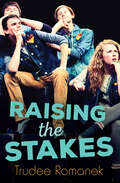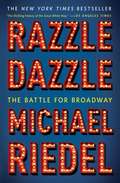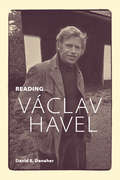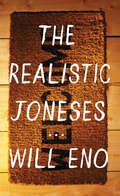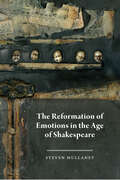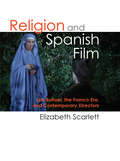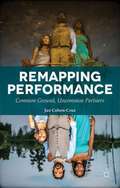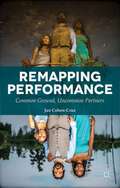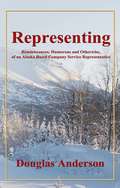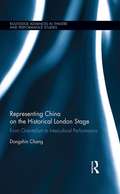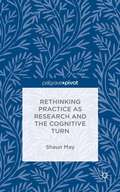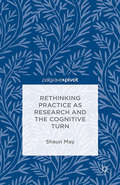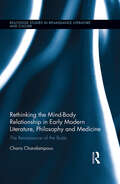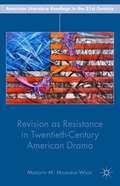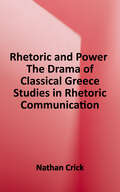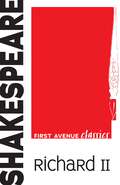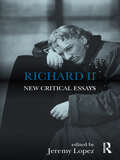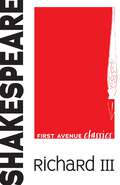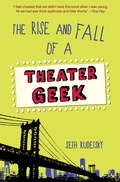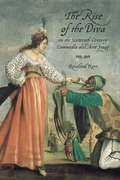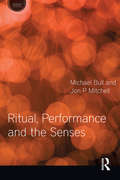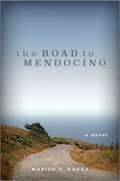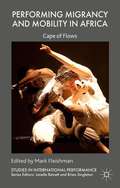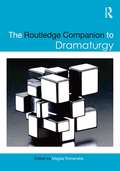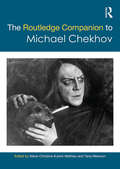- Table View
- List View
Raising the Stakes (Orca Limelights)
by Trudee TomanekIt's the start of a new season for Harrington High's improv team--and Chloe is determined that this will be the year they make it all the way to the top. Her teammates (who also happen to be her closest friends) are a talented bunch, and she knows they can do it. They have to. Because getting to nationals is Chloe's best chance to prove--to her parents, to the improv scouts and, most of all, to herself--that she has what it takes to succeed. Chloe is doing everything she can to help her teammates perform better. So why are they all mad at her?
Razzle Dazzle: The Battle for Broadway
by Michael Riedel&“A vivid page-turner&” (NPR) detailing the rise, fall, and redemption of Broadway—its stars, its biggest shows, its producers, and all the drama, intrigue, and power plays that happened behind the scenes.&“A rich, lovely, debut history of New York theater in the 1970s and eighties&” (Kirkus Reviews, starred review), Razzle Dazzle is a narrative account of the people and the money and the power that turned New York&’s gritty back alleys and sex-shops into the glitzy, dazzling Great White Way.In the mid-1970s Times Square was the seedy symbol of New York&’s economic decline. Its once shining star, the renowned Shubert Organization, was losing theaters to make way for parking lots and losing money. Bernard Jacobs and Jerry Schoenfeld, two ambitious board members, saw the crumbling company was ripe for takeover and staged a coup and staved off corporate intrigue, personal betrayals and criminal investigations. Once Jacobs and Schoenfeld solidified their power, they turned a collapsed theater-owning holding company into one of the most successful entertainment empires in the world, spearheading the revitalization of Broadway and the renewal of Times Square.&“For those interested in the business behind the greasepaint, at a riveting time in Broadway&’s and New York&’s history, this is the ticket&” (USA TODAY). Michael Riedel tells the stories of the Shubert Organization and the shows that re-built a city in grand style—including Cats, A Chorus Line, and Mamma Mia!—revealing the backstage drama that often rivaled what transpired onstage, exposing bitter rivalries, unlikely alliances, and inside gossip. &“The trouble with Razzle Dazzle is…you can&’t put the damn thing down&” (Huffington Post).
Reading Václav Havel
by David S. DanaherAs a playwright, a dissident, and a politician, Václav Havel was one of the most important intellectual figures of the late twentieth century. Working in an extraordinary range of genres - poetry, plays, public letters, philosophical essays, and political speeches - he left behind a range of texts so diverse that scholars have had difficulty grappling with his oeuvre as a whole.In Reading Václav Havel, David S. Danaher approaches Havel's remarkable body of work holistically, focusing on the language, images, and ideas which appear and reappear in the many genres in which Havel wrote. Carefully reading the original Czech texts alongside their English versions, he exposes what in Havel's thought has been lost in translation. A passionate argument for Havel's continuing relevance, Reading Václav Havel is the first book to capture the fundamental unity of his vast literary legacy.
The Realistic Joneses
by Will Eno"[A] tender, funny, terrific new play. . . . Mr. Eno's voice, which teases out the poetry in the pedestrian and finds glinting humor in the static that infuses our faltering efforts to communicate, is as distinctive as any American playwright's today."--The New York Times"Weird and wonderful . . . Eno's familiar sudden-shifting between profound and playful verbiage is delightfully disarming and sometimes awfully funny."--Variety"Plays as funny and moving, as wonderful and weird as The Realistic Joneses... do not appear often on Broadway. Or ever, really.... Mr. Eno's voice may be the most singular of his generation, but it's humane, literate and slyly hilarious.... For all the sadness woven into its fabric, The Realistic Joneses brought me a pleasurable rush virtually unmatched by anything I've seen this season." - The New York Times"As usual, Eno's dialogue is a marvel of compression and tonal control, trivial chitchat flipping into cosmic profundity with striking ease.... There's much to savor: the dry but meaningful banter, the joy of humans sharing time and space, battling the darkness with a joke or silence. Life in Enoland isn't what you'd call realistic--it's more real than that." - Time Out New York "[An] elliptical, funny, dark and strangely moving new play.... Eno is a writer with heart and compassion." - Chicago Tribune"Eno's first-ever commercial foray ups the creative ante in a Broadway climate that can be resistant to new voices.... [A] very fine play where laughter exists a heartbeat, or heartbreak, away from tears." - The TelegraphMeet Bob and Jennifer and their new neighbors John and Pony, two suburban couples who have more in common than their identical last names. Boasting the playwright's quintessential existential quirkiness, this new comedy finds poetry in the banal while humorously exploring our ever-floundering efforts at communication. Listed as one of New York Times's Best Plays of 2012, The Realistic Joneses received its Broadway premiere in spring 2014, starring Toni Collete, Michael C. Hall, Tracy Letts and Marisa Tomei, and opening to rave reviews.Will Eno is the author of Thom Pain (based on nothing), which ran for a year Off-Broadway and was a 2005 Pulitzer Prize finalist. Other works include Middletown, The Flu Season, Tragedy: a tragedy, Intermission, and Gnit, an adaptation of Henrik Ibsen's Peer Gynt. His many awards include the PEN/Laura Pels International Foundation for Theatre Award, the Horton Foote Prize, and the first-ever Marian Seldes/Garson Kanin Fellowship by the Theater Hall of Fame.
The Reformation of Emotions in the Age of Shakespeare
by Steven MullaneyThe crises of faith that fractured Reformation Europe also caused crises of individual and collective identity. Structures of feeling as well as structures of belief were transformed; there was a reformation of social emotions as well as a Reformation of faith. As Steven Mullaney shows in The Reformation of Emotions in the Age of Shakespeare, Elizabethan popular drama played a significant role in confronting the uncertainties and unresolved traumas of Elizabethan Protestant England. Shakespeare and his contemporaries--audiences as well as playwrights--reshaped popular drama into a new form of embodied social, critical, and affective thought. Examining a variety of works, from revenge plays to Shakespeare's first history tetralogy and beyond, Mullaney explores how post-Reformation drama not only exposed these faultlines of society on stage but also provoked playgoers in the audience to acknowledge their shared differences. He demonstrates that our most lasting works of culture remain powerful largely because of their deep roots in the emotional landscape of their times.
Religion and Spanish Film: Luis Buñuel, the Franco Era, and Contemporary Directors
by Elizabeth ScarlettTreatments of religion found in Spanish cinema range from the pious to the anticlerical and atheistic, and every position in between. In a nation with a strong Catholic tradition, resistance to and rebellion against religious norms go back almost as far as the notion of "Sacred Spain." Religion and Spanish Film provides a sustained study of the religious film genre in Spain practiced by mainstream Francoist film makers, the evolving iconoclasm, parody, and reinvention of the Catholic by internationally renowned Surrealist Luis Buñuel, and the ongoing battle of the secular versus the religious manifested in critically and popularly acclaimed directors Pedro Almodóvar, Julio Medem, Alejandro Amenábar, and many others. The conflicted Catholicism that emerges from examining religious themes in Spanish film history shows no sign of ending, as unresolved issues from the Civil War and Franco dictatorship, as well as the unsettled relationship between Church and State, continue into the present.
Remapping Performance: Common Ground, Uncommon Partners
by Jan Cohen-CruzCompleting a trilogy of works by Jan Cohen-Cruz, Remapping Performance focuses on the work of artists and experts who collaborate across fields to address social issues. The book explores work of a range of artists who employ artistic training, methodologies and mind-sets in their work with experts from other sectors such as medicine and healthcare and from other disciplines, to draw an expanded map of performance platforms including university/ community partnerships, neighbourhood-bases, and cultural diplomacy. Case studies include ArtSpot Productions/Mondo Bizarro's Cry You One about climate change in southern Louisiana, incorporating theatrics and organizing; Michael Rohd/Sojourn Theatre's social and civic practices; Anne Basting's University of Wisconsin-Milwaukee-based integration of performance and creative aging; and the collaborative cultural diplomacy experiment, smARTpower. Short companion pieces add expertise from Helen Nicholson, Todd London, Julie Thompson Klein, Nancy Cantor, Maria Rosario Jackson, and Penny Von Eschen. Jan Cohen-Cruz ends with suggestions for fully integrating performance in cross-sector initiatives. This latest book by a leading figure in engaged/ applied theatre and performance builds on its predecessors by offering a future-oriented perspective, a vision of art and performance interacting with a range of social sectors and with an emphasis on HE in such partnerships, and will be a 'must-read' for all students and scholars working in this field.
Remapping Performance: Common Ground, Uncommon Partners
by Jan Cohen-CruzCompleting a trilogy of works by Jan Cohen-Cruz, Remapping Performance focuses on the work of artists and experts who collaborate across fields to address social issues. The book explores work of a range of artists who employ artistic training, methodologies and mind-sets in their work with experts from other sectors such as medicine and healthcare and from other disciplines, to draw an expanded map of performance platforms including university/ community partnerships, neighbourhood-bases, and cultural diplomacy. Case studies include ArtSpot Productions/Mondo Bizarro's Cry You One about climate change in southern Louisiana, incorporating theatrics and organizing; Michael Rohd/Sojourn Theatre's social and civic practices; Anne Basting's University of Wisconsin-Milwaukee-based integration of performance and creative aging; and the collaborative cultural diplomacy experiment, smARTpower. Short companion pieces add expertise from Helen Nicholson, Todd London, Julie Thompson Klein, Nancy Cantor, Maria Rosario Jackson, and Penny Von Eschen. Jan Cohen-Cruz ends with suggestions for fully integrating performance in cross-sector initiatives. This latest book by a leading figure in engaged/ applied theatre and performance builds on its predecessors by offering a future-oriented perspective, a vision of art and performance interacting with a range of social sectors and with an emphasis on HE in such partnerships, and will be a 'must-read' for all students and scholars working in this field.
Representing: Reminiscences; Humorous and Otherwise, of an Alaska Based Company Service Representative
by Douglas AndersonDouglas Anderson, the author, was born in Derbyshire, England. After his father passed away, Douglas went to live on his Grandfather's farm. Never very interested in animal husbandry, he leaned more toward the mechanical aspects of farming: maintaining and operating machinery. After an apprenticeship in the mechanical field, Douglas joined Rolls-Royce and began an interesting and diverse career. In the ensuing years, that career encompassed: jet engines, rocket engines and industrial gas turbines. Douglas immigrated to Canada in 1967, to the USA in 1977 and back to Canada in 2001. An adventurous fourteen years while supporting RR products in Alaska prompted Douglas to write and to become a published author. For many years, Anderson traveled and represented the company. Representing covers those years and some of the situations, humorous and otherwise, that he and his fellow Reps encountered at home base and at far-away places. The characters are real and these events actually happened as described. Most are documented for the first time in Representing.
Representing China on the Historical London Stage: From Orientalism to Intercultural Performance (Routledge Advances in Theatre & Performance Studies)
by Dongshin ChangThis book provides a critical study of how China was represented on the historical London stage in selected examples from the late seventeenth century to the early twentieth century—which corresponds with the Qing Dynasty (1644-1911), China’s last monarchy. The examples show that during this historical period, the stage representations of the country were influenced in turn by Jesuit writings on China, Britain’s expanding material interest in China, the presence of British imperial power in Asia, and the establishment of diasporic Chinese communities abroad. While finding that many of these works may be read as gendered and feminized, Chang emphasizes that the Jesuits’ depiction of China as a country of high culture and in perennial conflict with the Tartars gradually lost prominence in dramatic imaginations to depictions of China’s material and visual attractions. Central to the book’s argument is that the stage representations of China were inherently intercultural and open to new influences, manifested by the evolving combinations of Chinese and English (British) traits. Through the dramatization of the Chinese Other, the representations questioned, satirized, and put in sharp relief the ontological and epistemological bases of the English (British) Self.
Rethinking Practice as Research and the Cognitive Turn
by Shaun MayRethinking Practice as Research and the Cognitive Turn.
Rethinking Practice as Research and the Cognitive Turn
by S. MayThe last 15 years has seen an explosion of studies that use cognitive science to understand theatre, whilst at the same time theatre-makers are using their artistic practice to address research question. This book looks at the current discourse around these emerging fields.
Rethinking the Mind-Body Relationship in Early Modern Literature, Philosophy, and Medicine: The Renaissance of the Body (Routledge Studies in Renaissance Literature and Culture)
by Charis CharalampousThis book explores a neglected feature of intellectual history and literature in the early modern period: the ways in which the body was theorized and represented as an intelligent cognitive agent, with desires, appetites, and understandings independent of the mind. It considers the works of early modern physicians, thinkers, and literary writers who explored the phenomenon of the independent and intelligent body. Charalampous rethinks the origin of dualism that is commonly associated with Descartes, uncovering hitherto unknown lines of reception regarding a form of dualism that understands the body as capable of performing complicated forms of cognition independently of the mind. The study examines the consequences of this way of thinking about the body for contemporary philosophy, theology, and medicine, opening up new vistas of thought against which to reassess perceptions of what literature can be thought and felt to do. Sifting and assessing this evidence sheds new light on a range of historical and literary issues relating to the treatment, perception, and representation of the human body. This book examines the notion of the thinking body across a wide range of genres, topics, and authors, including Montaigne’s Essays, Spenser’s allegorical poetry, Donne’s metaphysical poetry, tragic dramaturgy, Shakespeare, and Milton’s epic poetry and shorter poems. It will be essential for those studying early modern literature, cognition, and the body.
Revision as Resistance in Twentieth-Century American Drama
by Meredith M. Malburne-WadeAmerican dramas consciously rewrite the past as a means of determined criticism and intentional resistance. While modern criticism often sees the act of revision as derivative, Malburne-Wade uses Victor Turner's concept of the social drama and the concept of the liminal to argue for a more complicated view of revision.
Rhetoric and Power: The Drama of Classical Greece (Studies in Rhetoric/Communication Series)
by Nathan CrickAn examination of how intellectuals and artists conceptualized rhetoric as a medium of power in a dynamic age of democracy and empire. <p><p> In Rhetoric and Power, Nathan Crick dramatizes the history of rhetoric by explaining its origin and development in classical Greece, beginning with the oral displays of Homeric eloquence in a time of kings, following its ascent to power during the age of Pericles and the Sophists, and ending with its transformation into a rational discipline with Aristotle in a time of literacy and empire. Crick advances the thesis that rhetoric is primarily a medium and artistry of power, but that the relationship between rhetoric and power at any point in time is a product of historical conditions, not the least of which is the development and availability of communication media. <p><p>Investigating major works by Homer, Heraclitus, Aeschylus, Protagoras, Gorgias, Thucydides, Aristophanes, Plato, Isocrates, and Aristotle, Rhetoric and Power tells the story of the rise and fall of classical Greece while simultaneously developing rhetorical theory from the close criticism of particular texts. As a form of rhetorical criticism, this volume offers challenging new readings to canonical works such as Aeschylus's Persians, Gorgias's Helen, Aristophanes's Birds, and Isocrates's Nicocles by reading them as reflections of the political culture of their time. Through this theoretical inquiry, Crick uses these criticisms to articulate and define a plurality of rhetorical genres and concepts, such as heroic eloquence, tragicomedy, representative publicity, ideology, and the public sphere, and their relationships to different structures and ethics of power, such as monarchy, democracy, aristocracy, and empire. <p><p>Rhetoric and Power thus provides a foundation for rhetorical history, criticism, and theory that draws on contemporary research to prove again the incredible richness of the classical tradition for contemporary rhetorical scholarship and practice.
Richard II (First Avenue Classics ™)
by William ShakespeareThe year is 1398, and the people of England are in a state of unrest. Richard II is not a popular king, as he puts his own interests before the interests of his people. Now he's gone a step too far; he has seized the lands and money of his dead uncle. Richard's cousin, Henry Bolingbroke, was meant to be the heir to this inheritance, and he is incensed that Richard has taken what is rightfully his. When Richard leaves for Ireland to fight a war, Henry takes advantage of his cousin's absence. He assembles an army and awaits Richard's return. A tale of rivalries and shifting power structures, this unabridged edition of the history play by English playwright William Shakespeare was written around 1595 and published in 1597.
Richard II: New Critical Essays (Shakespeare Criticism)
by Jeremy LopezArguably the first play in a Shakespearean tetralogy, Richard II is a unique and compelling political drama whose themes still resonate today. It is one of the few Shakespeare plays written entirely in verse and its format presents unique theatrical challenges. Politically engaged and controversial, it raises crucial debates about the relationship between early modern art, audience response and state power. This collection provides a comprehensive and up-to-date survey of the critical and theatrical history of the play. The substantial introduction surveys the history of critical interpretations of Richard II since the eighteenth century. The eleven newly written critical essays by leading and emerging scholars in the field then adopt an eclectic range of critical approaches that encourage scholars and students to pursue new and imaginative directions with the text.
Richard III: Large Print (First Avenue Classics ™)
by William ShakespeareTrouble is brewing for King Edward IV. Edward's youngest brother, Richard, is jealous of Edward's power and influence. Richard will do anything to overthrow the king: He manipulates a noblewoman into marrying him. He arranges for his brother Clarence to be executed, then blames Clarence's death on King Edward. After Edward becomes ill and dies, Richard attains the throne through villainous means. But Richard's trail of deception, manipulation, and murder might eventually be the cause of his own downfall. This unabridged edition of the history play written by English playwright William Shakespeare was written around 1592 and first published in 1597.
The Rise and Fall of a Theater Geek
by Seth Rudetsky<P>Broadway, New York. The shows, the neon lights . . . the cute chorus boys! It's where Justin has always wanted to be--and now, with a winter internship for a famous actor, he finally has his chance to shine. If only he could ditch his kind, virtuous, upright, and--dare he say it?--uptight boyfriend, Spencer. <P>But once the internship begins, Justin has more to worry about than a cramped single-guy-in-the-city style. Instead of having his moment in the spotlight, he's a not-so-glorified errand boy. Plus, Spencer is hanging out with a celebra-hottie, Justin's best friend Becky isn't speaking to him, and his famous actor boss seems headed for flopdom. Justin's tap-dancing as fast as he can, but all his wit and sass might not be enough to switch his time in New York from nightmare-terrible to dream-come-true terrific. <P>Seth Rudetsky's second YA novel is endearingly human, laugh-out-loud funny, and for any kid who's ever aspired to Broadway but can only sneak in through the stage door.
The Rise of the Diva on the Sixteenth-Century Commedia dell'Arte Stage
by Rosalind KerrThe Rise of the Diva on the Sixteenth-Century Commedia dell'Arte Stage examines the emergence of the professional actress from the 1560s onwards in Italy. Tracing the historical progress of actresses from their earliest appearances as sideshow attractions to revered divas, Rosalind Kerr explores the ways in which actresses commodified their sexual and cultural appeal.Newly translated archival material, iconographic evidence, literary texts, and theatrical scripts provide a rich repertoire through which Kerr demonstrates how actresses skillfully improvised roles such as the maidservant, the prima donna, and the transvestite heroine. Following the careers of early stars such as Flaminia of Rome, Vincenza Armani, Vittoria Piissimi, and Isabella Andreini, Kerr shows how their fame arose from the combination of dazzling technical mastery and eloquent powers of persuasion. Seamlessly integrating the Italian and English scholarly literature on the subject, The Rise of the Diva is an insightful analysis of one of the modern world's first celebrity cultures.
Ritual, Performance and the Senses (Sensory Studies)
by Michael BullRitual has long been a central concept in anthropological theories of religious transmission. Ritual, Performance and the Senses offers a new understanding of how ritual enables religious representations – ideas, beliefs, values – to be shared among participants. Focusing on the body and the experiential nature of ritual, the book brings together insights from three distinct areas of study: cognitive/neuroanthropology, performance studies and the anthropology of the senses. Eight chapters by scholars from each of these sub-disciplines investigate different aspects of embodied religious practice, ranging from philosophical discussions of belief to explorations of the biological processes taking place in the brain itself. Case studies range from miracles and visionary activity in Catholic Malta to meditative practices in theatrical performance and include three pilgrimage sites: the Church of the Holy Sepulchre in Jerusalem, the festival of Ramlila in Ramnagar, India and the mountain shrine of the Lord of the Shiny Snow in Andean Peru.Understanding ritual allows us to understand processes at the very centre of human social life and humanity itself, making this an invaluable text for students and scholars in anthropology, cognitive science, performance studies and religious studies.
The Road To Mendocino
by Marion O. HannaIn THE ROAD TO MENDOCINO, M. B. Wright, a feisty Southern lawyer, agrees to help a colleague whose daughter is missing, last seen with M. B. 's nemesis, the politically powerful Judge Augustine. The search takes her to Washington, D. C. where the sudden appearance of her abusive ex-husband plunges her back into the depths of the life she had worked so hard to escape, making her quest to find Caroline that much more difficult. To deal with her misgivings, she visits Duncan's other ex-wife via the treacherous and beautiful California Highway 1. Meanwhile, Judge Augustine puts pressure on M. B. 's staff to bring her back and face the music he has waiting for her.
Romanticism and the Museum: Cape Of Flows (Studies In International Performance Ser.)
by Emma PeacockePerforming Migrancy and Mobility in Africa focuses on a body of performance work, the work of Magnet Theatre in particular but also work by other artists in Cape Town and other parts of the continent or the world, that engages with the Cape as a real or imagined node in a complex system of migration and mobility. Located at the foot of the African continent, lodged between two oceans at the intersection of many of the earth's major shipping lanes, Cape Town is a stage for a powerful mixing of cultures and peoples and has been an important node in a network of flows, circuits of movement and exchange. The performance works studied here attempt to get to grips with what it feels like to be on the move and in the spaces in-between that characterises the lives, now and for centuries before, of multiple peoples who move around and pass through places like the Cape. The contributors are a broad range of mostly African authors from various parts of the continent and as such the book offers an insight into new thinking and new approaches from an emerging and important location.
The Routledge Companion to Dramaturgy (Routledge Companions)
by Magda RomanskaDramaturgy, in its many forms, is a fundamental and indispensable element of contemporary theatre. In its earliest definition, the word itself means a comprehensive theory of "play making." Although it initially grew out of theatre, contemporary dramaturgy has made enormous advances in recent years, and it now permeates all kinds of narrative forms and structures: from opera to performance art; from dance and multimedia to filmmaking and robotics. In our global, mediated context of multinational group collaborations that dissolve traditional divisions of roles as well as unbend previously intransigent rules of time and space, the dramaturg is also the ultimate globalist: intercultural mediator, information and research manager, media content analyst, interdisciplinary negotiator, social media strategist. This collection focuses on contemporary dramaturgical practice, bringing together contributions not only from academics but also from prominent working dramaturgs. The inclusion of both means a strong level of engagement with current issues in dramaturgy, from the impact of social media to the ongoing centrality of interdisciplinary and intermedial processes. The contributions survey the field through eight main lenses: world dramaturgy and global perspective dramaturgy as function, verb and skill dramaturgical leadership and season planning production dramaturgy in translation adaptation and new play development interdisciplinary dramaturgy play analysis in postdramatic and new media dramaturgy social media and audience outreach. Magda Romanska is Visiting Associate Professor of Slavic Languages and Literatures at Harvard University, Associate Professor of Theatre and Dramaturgy at Emerson College, and Dramaturg for Boston Lyric Opera. Her books include The Post-Traumatic Theatre of Grotowski and Kantor (2012), Boguslaw Schaeffer: An Anthology (2012), and Comedy: An Anthology of Theory and Criticism (2014).
The Routledge Companion to Michael Chekhov (Routledge Companions)
by Marie Christine Autant Mathieu Yana MeerzonThe Routledge Companion to Michael Chekhov brings together Chekhov specialists from around the world - theatre practitioners, theorists, historians and archivists – to provide an astonishingly comprehensive assessment of his life, work and legacy. This volume aims to connect East and West; theatre theory and practice. It reconsiders the history of Chekhov’s acting method, directing and pedagogy, using the archival documents found across the globe: in Russia, England, America, Germany, Lithuania and Switzerland. It presents Chekhov’s legacy and ideas in the framework of interdisciplinary theatre practices and theories, as well as at the crossroads of cultures, in the context of his forays into such areas as Western mime and Asian cosmology. This remarkable Companion, thoughtfully edited by two leading Chekhov scholars, will prove invaluable to students and scholars of theatre, theatre practitioners and theoreticians, and specialists in Slavic and transcultural studies. Marie-Christine Autant-Mathieu is Director of Research at the National Center For Scientific Research, and Assistant-Director of Sorbonne-CNRS Institute EUR’ORBEM. She is an historian of theatre and specialist in Russian and Soviet theatre.Yana Meerzon is Associate Professor in the Department of Theatre, University of Ottawa. Her book publications include Adapting Chekhov: The Text and Its Mutations, co-edited with Professor J. Douglas Clayton, University of Ottawa (Routlegde, 2012).
